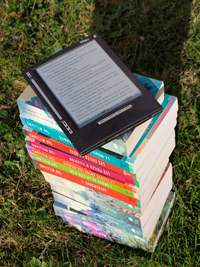
Source: Angry Mother and Daughter Therapy, iStockphoto
Have you ever come home after going out with your friends and your parents start quizzing you about where you’ve been and what you were doing? That’s when it begins, the game of twenty questions that seems to go on forever. Depending on your mood, you might play along and provide lots of details about your activities. A lot of parents seem to love getting information. You might instead choose to elaborate as little as possible. Sometimes parents don’t seem to need every itty bitty detail and will cut you some slack. Whatever you choose to say, you will probably include some summarizing and critiquing in your conversation.

Source: Bouquin électronique iLiad sur une pile de livre dehors au soleil, Martouf, Wikimedia
In addition to such conversations (fun or otherwise), you have probably read summaries and critiques in movie reviews, book reviews, vacation guides, newspaper editorial sections, or online product reviews. Some guides and reviews are either summaries or critiques; some are combinations of the two.
This lesson will focus on summary and critique separately so that you can distinguish between the two. You will learn how to summarize a text and how to distinguish between essential and nonessential information when summarizing. You will also learn how to write a critique that includes credible support, not unsubstantiated evidence.